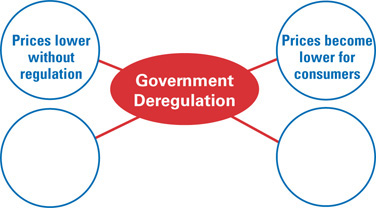Chapter 7 Assessment
Chapter Summary
A summary of major ideas in Chapter 7 appears below. See also the Guide to the Essentials of Economics, which provides additional review and test practice of key concepts in Chapter 7.
-
Section 1 Perfect Competition (pp. 151–154)
Perfect competition describes a market with many well-informed buyers and sellers, identical goods, and no barriers to entry to stop companies from joining the market. Perfect competition is only found in markets that deal in commodities, or goods that are identical no matter who produces or sells them. These markets are efficient at setting output and prices at a level that is beneficial to all.
-
Section 2 Monopoly (pp. 156–164)
A firm is a monopolist when it is the only seller in a market. A natural monopoly is an industry that works best when only one firm serves the entire market. Government can create a monopoly by issuing a patent, franchise, or a license. A monopolist can set prices or output. Firms use price discrimination to divide consumers into groups based on their ability to pay, and then offer a different price to each group.
-
Section 3 Monopolistic Competition and Oligopoly (pp. 166–171)
Most markets fall somewhere between perfect competition and monopoly. Monopolistic competition is similar to perfect competition, except that companies sell slightly different goods and have a little power to set prices. Closer to monopoly, oligopoly describes a market dominated by a few large producers. Firms in an oligopoly can practice collusion or form a cartel to set prices like a monopoly.
-
Section 4 Regulation and Deregulation (pp. 172–176)
Firms in an oligopoly can merge to try to gain monopoly power. Because monopoly power can lead to inefficient markets, the federal government has passed laws to promote competition and break up monopolies. In the late 1970s and 1980s, government gave up power to regulate several markets. Deregulation has led to lower prices in most deregulated markets.
Key Terms
Complete each sentence by choosing the correct answer from the list of terms below. You will not use all of the terms.
- perfect competition
- oligopoly
- patent
- commodities
- price discrimination
- natural monopoly
- economies of scale
- price fixing
- deregulation
- collusion
- ______ is when a monopolist divides consumers into groups and charges different prices for the same good.
- A market with many firms producing the same good is in ______.
- Economists define ______ as a market structure with a few large firms, each of which has some market power.
- ______ are products that are identical no matter who produces them.
- A(n) ______ grants the right to sell an invention without competition.
- A(n) ______ may exist in markets where it is most efficient for only one large firm to provide a product.
- Economists use the term ______ to describe agreements among firms to set prices and production levels.
Using Graphic Organizers
-
On a separate sheet of paper, copy the multi-flow map below. Organize information on government deregulation by completing the map with causes for deregulation on the left and possible effects on the right. You may add more causes or effects.





